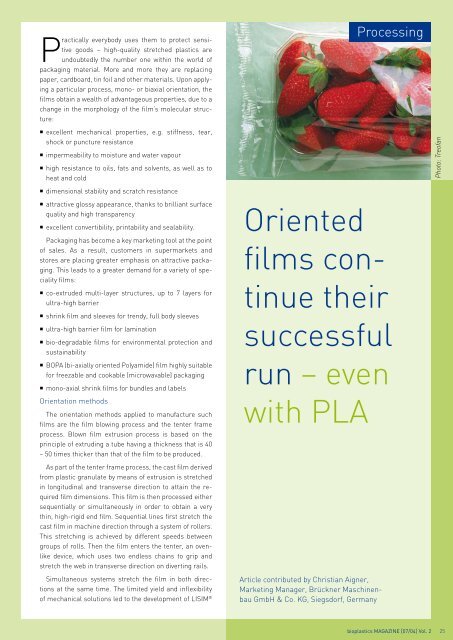bioplasticsMAGAZINE_0704
bioplasticsMAGAZINE_0704
bioplasticsMAGAZINE_0704
Create successful ePaper yourself
Turn your PDF publications into a flip-book with our unique Google optimized e-Paper software.
Practically everybody uses them to protect sensitive<br />
goods – high-quality stretched plastics are<br />
undoubtedly the number one within the world of<br />
packaging material. More and more they are replacing<br />
paper, cardboard, tin foil and other materials. Upon applying<br />
a particular process, mono- or biaxial orientation, the<br />
films obtain a wealth of advantageous properties, due to a<br />
change in the morphology of the film’s molecular structure:<br />
• excellent mechanical properties, e.g. stiffness, tear,<br />
shock or puncture resistance<br />
• impermeability to moisture and water vapour<br />
• high resistance to oils, fats and solvents, as well as to<br />
heat and cold<br />
• dimensional stability and scratch resistance<br />
• attractive glossy appearance, thanks to brilliant surface<br />
quality and high transparency<br />
• excellent convertibility, printability and sealability.<br />
Packaging has become a key marketing tool at the point<br />
of sales. As a result, customers in supermarkets and<br />
stores are placing greater emphasis on attractive packaging.<br />
This leads to a greater demand for a variety of speciality<br />
films:<br />
• co-extruded multi-layer structures, up to 7 layers for<br />
ultra-high barrier<br />
• shrink film and sleeves for trendy, full body sleeves<br />
• ultra-high barrier film for lamination<br />
• bio-degradable films for environmental protection and<br />
sustainability<br />
• BOPA (bi-axially oriented Polyamide) film highly suitable<br />
for freezable and cookable (microwavable) packaging<br />
• mono-axial shrink films for bundles and labels<br />
Orientation methods<br />
The orientation methods applied to manufacture such<br />
films are the film blowing process and the tenter frame<br />
process. Blown film extrusion process is based on the<br />
principle of extruding a tube having a thickness that is 40<br />
– 50 times thicker than that of the film to be produced.<br />
As part of the tenter frame process, the cast film derived<br />
from plastic granulate by means of extrusion is stretched<br />
in longitudinal and transverse direction to attain the required<br />
film dimensions. This film is then processed either<br />
sequentially or simultaneously in order to obtain a very<br />
thin, high-rigid end film. Sequential lines first stretch the<br />
cast film in machine direction through a system of rollers.<br />
This stretching is achieved by different speeds between<br />
groups of rolls. Then the film enters the tenter, an ovenlike<br />
device, which uses two endless chains to grip and<br />
stretch the web in transverse direction on diverting rails.<br />
Simultaneous systems stretch the film in both directions<br />
at the same time. The limited yield and inflexibility<br />
of mechanical solutions led to the development of LISIM ®<br />
Oriented<br />
films continue<br />
their<br />
Processing<br />
successful<br />
run – even<br />
with PLA<br />
Article contributed by Christian Aigner,<br />
Marketing Manager, Brückner Maschinenbau<br />
GmbH & Co. KG, Siegsdorf, Germany<br />
Photo: Treofan<br />
bioplastics MAGAZINE [07/04] Vol. 2 25


















